Grade 2 Titanium Tube for Heat Exchangers
Applicable Standards & Design Codes
Product standards: ASTM B338 / ASME SB-338 for tubes; matching plates use ASTM B265 / SB-265.
Allowable stress basis: ASME BPVC Section II-D. For thinner walls consider Grade 2H / 7H / 12H.
Industry Practice / Field Rules
- Keep tube-side velocity ≥ 2 m/s or apply 0.5 ppm chlorine (continuous or intermittent).
- Flush with fresh water and dry before & after long shutdowns to reduce deposits and crevice zones.
Chemical Composition (ASTM B338)
| Element | Max (%) |
|---|---|
| C | 0.1 |
| Fe | 0.3 |
| O | 0.25 |
| N | 0.03 |
| H | 0.0125 |
| Others (each/total) | 0.10 / 0.40 |
| Ti | Balance |
Mechanical & Physical Properties (room temp, annealed)
| Property | Value |
|---|---|
| Tensile strength | ≥345 MPa |
| Yield strength Rp0.2 | ≥275 MPa |
| Elongation | ≥20% |
| Elastic modulus | 105 GPa |
| Density | 4.51 g/cm³ |
| Thermal conductivity | 16.4 W·m⁻¹·K⁻¹ |
| CTE (20-100 °C) | 8.6 µm·m⁻¹·K⁻¹ |
| Specific heat | 0.523 J·g⁻¹·K⁻¹ |
Grade 2 Tube Stock & Services
All sizes are in stock and can be cut to length ±1 mm. We offer chamfering, pickling, sand-blasting, polishing, PMI re-inspection, and SGS/TÜV third-party testing. Need other diameters, wall thicknesses, or ASTM B861 process tubes? Tell us and we reply within 24 h.
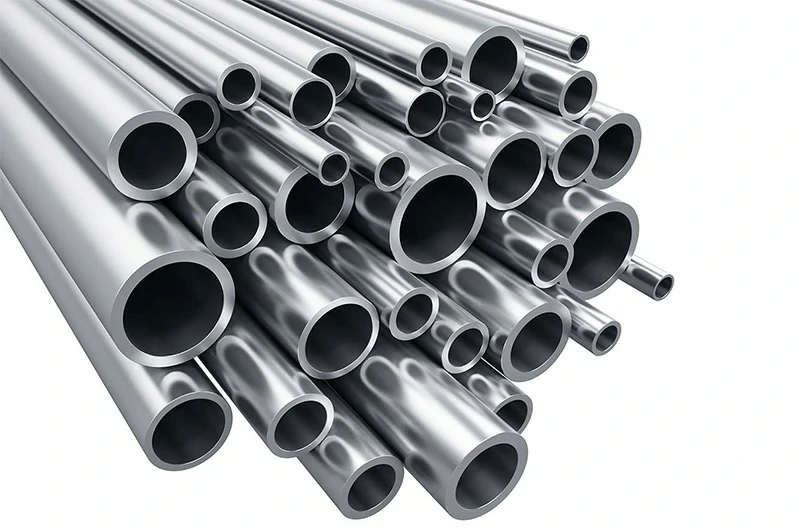
Click to view full Grade 2 tube inventory
| No. | OD (mm) | OD (inch) | WT (mm) | WT (inch) | Lenth (m) |
|---|---|---|---|---|---|
| 1 | 14 | 0.551 | 1.5 | 0.059 | 4.2 |
| 2 | 19 | 0.748 | 1.5 | 0.059 | 4 |
| 3 | 25 | 0.984 | 1.2 | 0.047 | 5 |
| 4 | 25 | 0.984 | 1.5 | 0.059 | 6 |
| 5 | 25 | 0.984 | 2 | 0.079 | 6 |
| 6 | 32 | 1.26 | 1.5 | 0.059 | 6 |
| 7 | 32 | 1.26 | 2 | 0.079 | 6 |
| 8 | 38 | 1.496 | 2 | 0.079 | 6 |
| 9 | 38 | 1.496 | 2.5 | 0.098 | 6 |
| 10 | 38 | 1.496 | 3 | 0.118 | 6 |
| 11 | 50 | 1.969 | 1.5 | 0.059 | 5 |
| 12 | 50 | 1.969 | 3 | 0.118 | 7.95 |
| 13 | 57 | 2.244 | 2 | 0.079 | 5.5 |
| 14 | 57 | 2.244 | 3 | 0.118 | 6 |
| 15 | 60 | 2.362 | 3 | 0.118 | 5 |
| 16 | 76 | 2.992 | 3 | 0.118 | 6 |
| 17 | 76 | 2.992 | 4 | 0.157 | 6 |
| 18 | 89 | 3.504 | 3 | 0.118 | 6 |
| 19 | 89 | 3.504 | 6 | 0.236 | 5.5 |
| 20 | 108 | 4.252 | 4 | 0.157 | 6 |
| 21 | 133 | 5.236 | 4 | 0.157 | 5.13 |
| 22 | 159 | 6.26 | 3 | 0.118 | 6 |
| 23 | 219 | 8.622 | 3 | 0.118 | 6 |
| 24 | 273 | 10.748 | 5 | 0.197 | 5 |
| 25 | 377 | 14.843 | 5 | 0.197 | 4.62 |
| 26 | 457 | 17.992 | 5 | 0.197 | 5.67 |
| 27 | 480 | 18.898 | 5 | 0.197 | 3.21 |
We also keep Grade 2 titanium dished heads and can ship them with tubes & fittings.
| No. | Diameter (mm) | Diameter (inch) | Thickness (mm) | Thickness (inch) |
|---|---|---|---|---|
| 1 | 450 | 17.717 | 3 | 0.118 |
| 2 | 460 | 18.11 | 3 | 0.118 |
| 3 | 610 | 24.016 | 6 | 0.236 |
| 4 | 710 | 27.953 | 5 | 0.197 |
| 5 | 900 | 35.433 | 6 | 0.236 |
| 6 | 1000 | 39.37 | 4 | 0.157 |
| 7 | 1010 | 39.764 | 8 | 0.315 |
| 8 | 1200 | 47.244 | 4 | 0.157 |
Quality Control & Delivery
NDE: ECT and UT to ASTM B338.
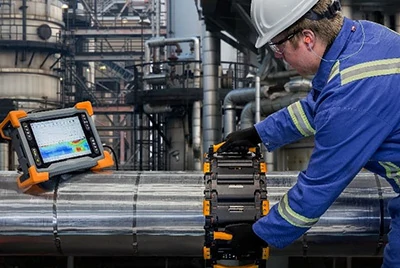
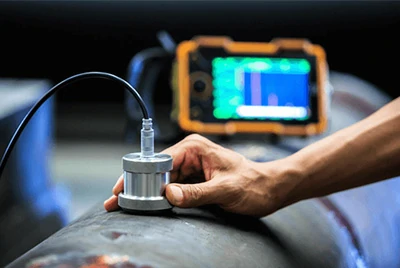
Hydrotest: Every tube at 1.5 × design pressure.
MTC: EN 10204 3.1 / 3.2 with full traceability.
Packing: End caps, desiccant, shock-proof crates; moisture cards for sea freight.
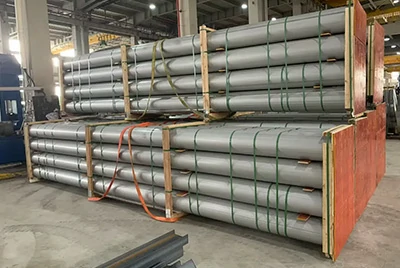

Procurement / Selection Checklist
Medium chemistry, Cl-, pH, solids
Temperature profile; any point > 82 °C?
Design velocity; if < 2 m/s, is chlorination allowed?
Design pressure & corrosion allowance
Design life vs downtime tolerance
Code: ASME Sec I/VIII, Div.1 or Div.2
Tube-sheet/shell materials & galvanic measures
NDE, 100 % hydro, third-party witness
Docs needed, packing, Incoterms, MOQ, lead time
TL;DR (1-Minute Decision)
ASTM B338 covers seamless and welded Grade 2 (UNS R50400) titanium tubes. It is widely used in surface condensers, evaporators, and other heat exchangers.
Typical minimum mechanical properties (annealed): UTS ≥ 345 MPa, 0.2% YS ≥ 275 MPa, El ≥ 20%. This gives a good balance of strength and weldability for most chemical and seawater-cooling duties.
Thermal conductivity is ~16.4 W·m⁻¹·K⁻¹ at room temperature, much lower than Cu‑Ni. But titanium tolerates very high velocities. Reports show up to 40 m/s in seawater without erosion–corrosion. Engineers compensate the lower λ with higher velocity, thinner walls, and more compact layouts.
Corrosion resistance in seawater and most chloride media is essentially "fit and forget.” No MIC cases have been reported. If velocity is < 2 m/s, dose ~0.5 ppm chlorine (continuous or intermittent) to control biofouling.
ASME BPVC Section II‑D provides allowable stresses for Grade 2 used in Sections I and VIII. Always size the wall using these S values, not room‑temperature tensile or yield strengths.
Field data show >30 years in seawater with no measurable corrosion, and 16 years in polluted seawater with stable performance.
This track record makes Grade 2 a default choice for seawater cooling, desalination, LNG, and many chemical plants.
Design Essentials
Low thermal conductivity vs. high allowable velocity
Titanium's λ is only 1/4–1/5 of Cu‑Ni. But you can run higher velocity (and turbulence), which raises the convective coefficient h. With thinner walls (ASTM B338 allows feasible thin gauges) and higher surface-area density, the overall U can still meet the target.
Wall thickness selection & allowable stress
Use the S values in ASME BPVC Section II‑D (temperature dependent). Do not size walls with yield or tensile strengths. When needed, consider Grade 2H / 7H / 12H to further reduce wall thickness.
Velocity window
Recommend ≥ 2 m/s to limit biofouling. Typical designs run 2–8 m/s (6–26 ft/s).
Extreme upper bound: materials have been shown to tolerate 30–40 m/s, but you must also check pump power, noise, vibration, and tube bundle support.
Welding & tube expansion
Grade 2 titanium is best welded by GTAW (TIG) / PAW with strict inert shielding to avoid O/N pickup.
For Ti tubes to Ti or Ti‑clad tubesheets, automatic multi‑torch GTAW seal welding is common to minimize crevice sites. The Nickel Institute reports positive galvanic compatibility for Ti tubes + high‑alloy stainless waterboxes/tubesheets.
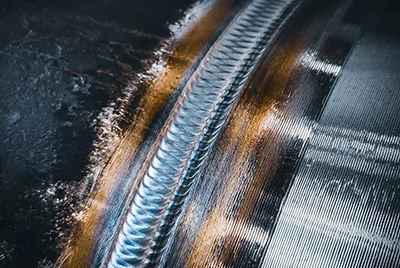

Why Grade 2 Ti Is the First Choice
Near "design and forget" corrosion life
In natural seawater, chloride media, and many acid/alkali systems, titanium forms a dense TiO₂ passive film. Field and lab data often show corrosion rates "near zero / not measurable”; typical values are ≤ 5 mpy (0.127 mm/y).
No reported MIC (microbiologically influenced corrosion)
This is a key differentiator versus stainless steels and Cu Ni alloys.
Higher allowable velocity → higher local heat transfer coefficient & less scaling
In seawater, 40 m/s (~130 ft/s) still causes negligible damage to the alloy; literature also reports tolerances >30 m/s. Typical engineering designs are far more conservative, e.g. 6–8 ft/s, and 12–15 ft/s when higher performance is required.
If velocity is < 2 m/s due to design or operation, apply ~0.5 ppm chlorination to maintain antifouling capability.
Good weldability and manufacturability, with full ASME/ASTM coverage
ASTM B338 stipulates chemistry, mechanical properties, dimensions, NDE, and hydrostatic testing for seamless/welded titanium tubes used in heat exchangers.
ASME Section II D provides design allowable stresses; ASME Sections VIII / I permit its use in pressure vessels and boilers.
Corrosion / Failure Modes & Mitigation
Seawater / chloride environments
Uniform corrosion is almost absent. Long-term service commonly shows "no measurable corrosion.” But when T > 82 °C and tight crevices exist, Grade 2 can suffer crevice corrosion. In that case, select Pd alloy Grades 7/16 or Mo modified Grade 12.
Biofouling control
Keep tube-side velocity ≥ 2 m/s. If you cannot, use ~0.5 ppm chlorination to suppress fouling.
Stress corrosion cracking (SCC)
Immune to chloride SCC in seawater, a key advantage over austenitic stainless steels.
Erosion / impingement corrosion
In seawater, 40 m/s (~130 ft/s) still has negligible effect. Even with sand, the impact is small. This lets you raise velocity to trade area in design.
Galvanic corrosion
Titanium itself is not sacrificed, but it can accelerate corrosion of more active metals (e.g., carbon steel, Cu Ni) when coupled. Good practice: Ti tubes + high alloy stainless or Ti clad tubesheets, and sacrificial anodes on carbon steel parts.
FAQ (Translated)
Q1: Why not use Cu-Ni or stainless?
Cu-Ni and austenitic stainless suffer erosion, SCC, or MIC in seawater. Maintenance is costly, so Ti wins on life-cycle cost.
Q2: Will low λ make the exchanger huge?
No. Thin walls and high velocity compensate. Actual HX size does not scale linearly with λ.
Q3: Can I use Grade 2 above 82 °C seawater?
Risk of crevice corrosion exists; switch to Pd-alloy G7 or Mo-alloy G12.
Q4: How to pick ASME allowable stress?
Use S values in ASME II-D Table 1A/1B. For thinner walls consider 2H/7H/12H.




